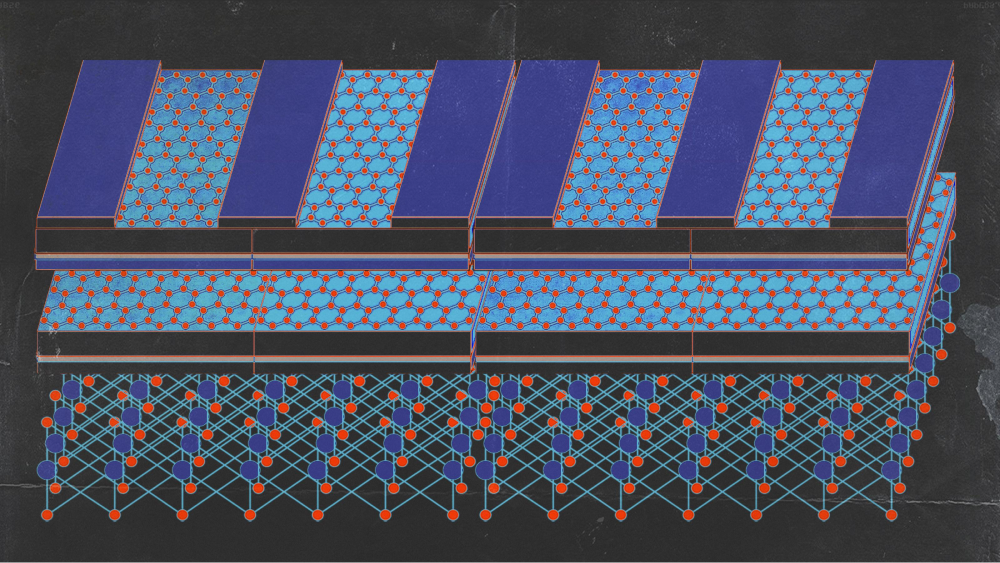Condenced Matter and Superconductivity
Physicist Cedric Weber on high-temperature superconductivity, the highest possible critical temperature, and ...

The rapid development of quantum computing is inseparable from the study of quantum properties of materials. Materials are the key to overcoming decoherence, the main obstacle to building an efficient quantum computer.
The 20th century can be called the century of the quantum revolution: the discovery of quantum mechanics, the study of its laws, and the detailed exploration of quantum phenomena have significantly advanced science. For example, unlike classical physics, quantum approaches allowed for a complete solution to the problem of blackbody radiation, the development of hydrogen atom theory, and the explanation of wave-particle duality.
Today, so-called quantum materials have become one of the most promising fields of study, as their research is tied to the development of quantum computing, which is resistant to particle decoherence. Since this area of modern science is relatively young, there has yet to be a clear, unified definition of what constitutes a quantum material and how it differs from other substances. Before quantum mechanics existed in the late 19th and early 20th centuries, all physical phenomena were described using classical physics. However, some unsolved problems led scientists to develop a fundamentally new quantum approach to explain physical phenomena in microsystems (for example, the planetary atom model proposed by Niels Bohr in 1913, where the electron did not follow the rules of classical physics).
According to modern understanding, quantum theory most accurately describes the phenomena of the surrounding world, meaning that all materials and their interactions are of a quantum nature. Classical laws can explain them on a macroscopic scale, but the quantum approach is indispensable for microsystems. Nonetheless, there are certain materials whose quantum properties persist from the microscopic to the macroscopic scale, making the classical approach inapplicable to them. Therefore, quantum materials can be defined as substances whose quantum properties are retained or manifest on macroscopic scales.
One of the earliest and most well-known examples of quantum materials is superconductors. In 1911, during experiments with mercury cooled to 4 kelvins, Kamerlingh Onnes discovered that mercury’s electrical resistance drops to zero under such conditions. This state of matter became known as superconducting, and the material itself was called a superconductor. Superconducting materials possess another attractive property: they expel magnetic fields from their volume, a phenomenon known as the “Meissner effect.”
Today, many materials are known to become superconductors under certain conditions, such as low temperatures or extremely high pressure (around 2 million atmospheres). The most intriguing are so-called high-temperature superconductors, which exhibit superconducting properties at relatively higher temperatures—just below -200 °C. Unfortunately, many are ceramics (mixed oxides), making their technological application challenging. For instance, YBa₂Cu₃Oₓ can technically be made at home.
A quarter of a century after Kamerlingh Onnes’ experiments, another phenomenon of a similar nature was discovered—superfluidity. In 1937, Pyotr Kapitsa found that liquid helium would flow freely out of a container along its walls, even if they were much higher than the fluid level, and it could also seep through microcracks without friction. While superfluidity currently has no practical applications due to the high cost of materials and the difficulty of achieving such conditions, studying these phenomena is fundamentally valuable, so superfluid liquids continue to attract the interest of researchers.
The 20th century can be called the century of the quantum revolution: the discovery of quantum mechanics, the study of its laws, and the detailed exploration of quantum phenomena have significantly advanced science. For example, unlike classical physics, quantum approaches allowed for a complete solution to the problem of blackbody radiation, the development of hydrogen atom theory, and the explanation of wave-particle duality.
Today, so-called quantum materials have become one of the most promising fields of study, as their research is tied to the development of quantum computing, which is resistant to particle decoherence. Since this area of modern science is relatively young, there has yet to be a clear, unified definition of what constitutes a quantum material and how it differs from other substances. Before quantum mechanics existed in the late 19th and early 20th centuries, all physical phenomena were described using classical physics. However, many unsolved problems led scientists to develop a fundamentally new quantum approach to explain physical phenomena in microsystems (for example, the planetary atom model proposed by Niels Bohr in 1913, where the electron did not follow the rules of classical physics).
According to modern understanding, quantum theory most accurately describes the phenomena of the surrounding world, meaning that all materials and their interactions are of a quantum nature. Classical laws can explain them on a macroscopic scale, but the quantum approach is indispensable for microsystems. Nonetheless, there are certain materials whose quantum properties persist from the microscopic to the macroscopic scale, making the classical approach inapplicable to them. Therefore, quantum materials can be defined as substances whose quantum properties are retained or manifest on macroscopic scales.
Over the past 15 years, graphene—one of the allotropic forms of carbon—has captured the attention of many researchers. With a semiconductor-like structure, it conducts electricity well, has high thermal conductivity, and is incredibly strong. One of the most important properties of graphene is that its electrons behave similarly to ultra-relativistic particles—particles moving at speeds close to the speed of light. One consequence of this is that the light absorption in graphene, over a frequency range from terahertz to ultraviolet, is almost independent of frequency and is equal to the product of pi, the square of the electron charge, divided by the speed of light and Planck’s constant.
In 2005, graphene theoretically predicted and experimentally confirmed the quantum Hall effect in magnetic solid fields.
Graphene can be created in several ways, such as natural graphite. The essence of the method involves placing thin layers of graphite between special adhesive tapes and then sequentially peeling off graphite films until a sufficiently thin layer is obtained. After exfoliation, the thin graphite and graphene film tape is pressed against an oxidized silicon substrate. Graphene obtained in this way is called exfoliated graphene. Another method is molecular beam epitaxy, which, under ultra-high vacuum conditions, allows the growth of structures with a specified thickness. Carbon atoms are deposited on the substrate of a special vacuum chamber one by one, and they self-assemble into a graphene sheet. In a metal-organic deposition, vapors of different elements are introduced into the chamber, causing a chemical reaction that results in the formation of graphene on the surface.
Unfortunately, unlike the previous method, the graphene produced this way is of much lower quality and thus unsuitable for use in electronics. Therefore, exfoliated graphene is much more suitable for studying quantum effects than the graphene obtained from epitaxial chambers.
Graphene, too, could be viewed as a quantum material, as graphite is a bulk structure consisting of stacked graphene layers.
Thus, the effects associated with macroscopic quantum properties often manifest under certain specific conditions, whether through sufficiently low temperatures, high pressures, or intense magnetic fields. Consequently, the class of natural materials called quantum will likely continue to grow as experimental and theoretical physics develop.
The topological insulator is another well-known example of quantum materials currently being actively researched. Over 20 compounds have been identified as topological insulators, including bismuth telluride, bismuth selenide, cadmium telluride, mercury telluride, and others. Interestingly, unlike graphene, bismuth telluride can be grown quite well using epitaxial chambers. A topological insulator is a material that acts as an insulator on the inside—meaning it does not conduct electricity—but has so-called edge states on its surface that can conduct current. These edge states do not depend on any specific boundary conditions of the material.
Researchers have discovered several unique properties of the edge states in topological insulators, which are currently of great interest to the scientific community. These unusual properties could be used to create electronic circuits with minimal heat loss or to build quantum computers.
Since the late 19th century, the fact that a potential difference arises in a conductor placed in a magnetic field perpendicular to the current has been known—this is the so-called Hall effect. It was easily explained within the framework of classical physics as the result of the Lorentz force acting on charges moving through the conductor.
A century later, a scientific team led by Klaus von Klitzing discovered a similar phenomenon, but one that was more complex from a theoretical perspective—the quantum Hall effect. This effect occurs at low temperatures and in strong magnetic fields, where the resistance or conductivity in two-dimensional layered structures becomes quantized.
Researchers in the past century noticed exciting effects at the interface between layers of different materials. In sufficiently flat multilayered structures, electrons behave like a two-dimensional gas, meaning they are confined to a plane. In this case, quantum effects manifest in the direction perpendicular to this plane, such as a step-like dependence of conductivity on the magnetic field. The height of each step is exact, equaling an integer multiple of the ratio of the square of the electron charge to Planck’s constant—so accurate that this constant is used as a global standard for electrical resistance and calibrating measuring instruments. Remarkably, even though the specific material may vary and contain numerous defects, the constant remains unchanged.
In today’s world, quantum technologies are increasingly in demand across various fields yearly. Superconductors play a significant role in this development: they are already being used to create one of the most sought-after technologies—quantum computers—and other areas. One pressing issue today is the minimization of energy losses. Specifically, to conserve energy during the transmission of electrical current through wires, and more generally in electrical devices and power lines, it is essential to reduce energy losses caused by the heating of conductors. For this, conductors with minimal resistance are required—hence, superconducting materials, which have no resistance, play a crucial role in such technologies.
Superconducting materials also find essential medical applications, specifically MRI machines, familiar to us all. Since its introduction, magnetic resonance imaging has become the primary method for non-invasive diagnostics of brain diseases and muscle and skeletal conditions. The superconducting magnet coil used in MRI scanners comprises several layers of copper tape with a superconductor. In most MRI scanners today, the superconducting magnet is cooled with liquid helium to a temperature of about 4.2 kelvins. This method is entirely safe for health and provides the most accurate imaging, especially compared to techniques like X-rays.
Superconductors, topological insulators, and graphene are becoming commonplace in microelectronics and susceptible sensors. This will significantly increase the precision and resolution of measurements in fields such as medicine, manufacturing, astronomy, and the natural sciences.
These materials will also be indispensable in the computational technologies of the near future—quantum computers and spintronics-based devices. However, researchers still have much work ahead of them—both theoretical and experimental, as well as in technological optimization—before quantum materials become a part of our everyday lives.

Physicist Cedric Weber on high-temperature superconductivity, the highest possible critical temperature, and ...

UCL team of scientists proposed novel way for significantly improving data transfer

Inspired by nature, researchers come up with a new way to transmute the most abundant gas in the atmosphere un...